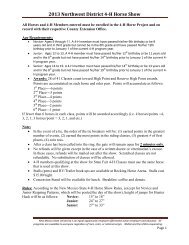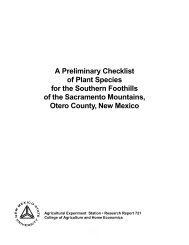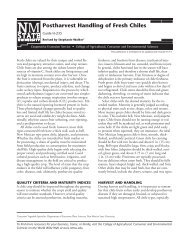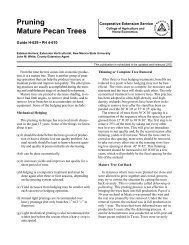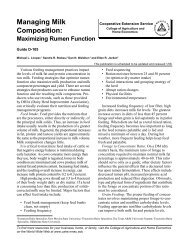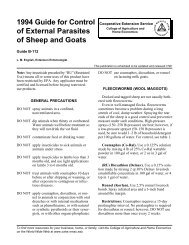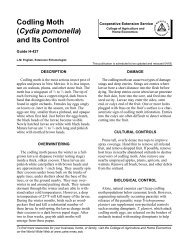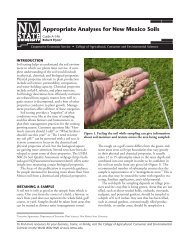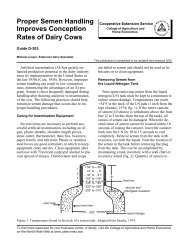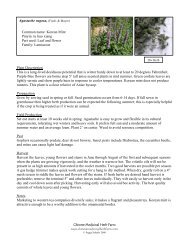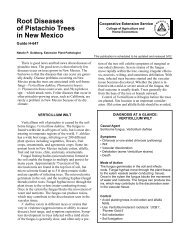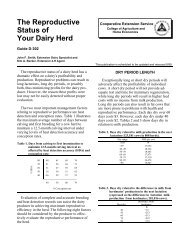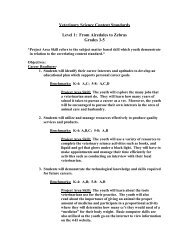Farm Resource Management (FRM) - College of Agricultural ...
Farm Resource Management (FRM) - College of Agricultural ...
Farm Resource Management (FRM) - College of Agricultural ...
Create successful ePaper yourself
Turn your PDF publications into a flip-book with our unique Google optimized e-Paper software.
AWATT <strong>Farm</strong> <strong>Resource</strong> <strong>Management</strong> Training ManualAgroecology takes greater advantage <strong>of</strong> natural processes and beneficial on-farm interactions inorder to reduce <strong>of</strong>f-farm input use and to improve the efficiency <strong>of</strong> farming systems.Technologies enhance the functional biodiversity <strong>of</strong> agroecosystems as well as the conservation<strong>of</strong> existing on-farm resources. Promoted technologies such as cover crops, green manures,intercropping, agr<strong>of</strong>orestry and crop-livestock mixtures are multi-functional, as their adoptionusually means favorable changes in other components <strong>of</strong> the farming systems at the same time.First, agroecology relies on indigenous farming knowledge and selected modern technologies tomanage diversity, incorporate biological principles and resources into farming systems, andintensify agricultural production. Second, it <strong>of</strong>fers a practical way to restore agricultural landsthat have been degraded by conventional agronomic practices. Third, it provides anenvironmentally sound and affordable way for smallholders to intensify production in marginalareas.Ecological concepts are used to favor natural processes and biological interactions that optimizesynergies so that diversified farms are able to sponsor their own soil fertility, crop protectionand productivity. By assembling crops, animals, trees, soils and other factors in spatial/temporaldiversified schemes, several processes are optimized. Such processes are crucial in determiningthe sustainability <strong>of</strong> agricultural systems (Altieri, 1995).AGROECOSYSTEM PROCESSES OPTIMIZED THROUGH THE USE OFAGROECOLOGICAL TECHNOLOGIESAgroecology takes greater advantage <strong>of</strong> natural processes and beneficial on-farm interactions inorder to reduce <strong>of</strong>f-farm input use and to improve the efficiency <strong>of</strong> farming systems.Technologies enhance the functional biodiversity <strong>of</strong> agroecosystems as well as the conservation<strong>of</strong> existing on-farm resources.Organic matter accumulation and nutrient cycling;Soil biological activity;Natural control mechanisms (disease suppression, biocontrol <strong>of</strong> insects, weedinterference);<strong>Resource</strong> conservation and regeneration (soil, water, germplasm, etc.);General enhancement <strong>of</strong> agrobiodiversity and synergism between components.ENHANCING PRODUCTIVITY THROUGH MULTI-SPECIES AGROECOSYSTEMSMany agricultural studies have shown that complex, multi-species agricultural systems are moredependable in production and more sustainable in terms <strong>of</strong> resource conservation thansimplified agroecosystems. Significant yield increases have been reported in diverse croppingsystems compared to monocultures. Enhanced yields in diverse cropping systems may resultfrom a variety <strong>of</strong> mechanisms, such as more efficient use <strong>of</strong> resources (light, water, nutrients)or reduced pest damage.Afghanistan Water, Agriculture and Technology Transfer Program 11



